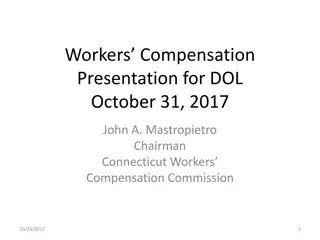Connecticut Nursing Home Closure Practices
Foundation of CT Closure Interventions: Grant Street Rehabilitation Center experienced closure in 1999 with a high proportion of Medicaid recipients and residents with significant physical and mental health needs. Current CT interventions involve the Nursing Home Financial Advisory Council and Distressed Nursing Home Conferences, addressing issues of financial solvency and quality care in nursing homes. The CT Nursing Home Financial Advisory Council, established under Public Act 14-55, directs a committee to assess nursing home infrastructure, needs, and quality of care. This council focuses on ensuring financial solvency aligns with maintaining high-quality care in nursing homes.
Download Presentation

Please find below an Image/Link to download the presentation.
The content on the website is provided AS IS for your information and personal use only. It may not be sold, licensed, or shared on other websites without obtaining consent from the author.If you encounter any issues during the download, it is possible that the publisher has removed the file from their server.
You are allowed to download the files provided on this website for personal or commercial use, subject to the condition that they are used lawfully. All files are the property of their respective owners.
The content on the website is provided AS IS for your information and personal use only. It may not be sold, licensed, or shared on other websites without obtaining consent from the author.
E N D
Presentation Transcript
Connecticut Nursing Home Closure Practices
Foundation of CT Closure Interventions Grant Street Rehabilitation Center Relocation Study Receivership closure in 1999 High proportion of Medicaid recipients High proportion of significant acuity-physical and mental health Large number of residents transferring quickly Questions of appropriate discharge planning Questions of residents pressured to move quickly Grant St Workgroup convened by the State Ombudsman-DSS, DMHAS, CLS, BRS, LMHA s Model became foundation for future CT closure interventions
Current CT Interventions CT Nursing Home Financial Advisory Council Distressed Nursing Home Conferences CT General Statute 17b-352, Certificate of Need CT General Statute 19a-533, Waiting Lists
CT Nursing Home Financial Advisory Council PUBLIC ACT 14-55, SECTION 2: SUMMARY Public Act 14-55, section 2[1]and section 17-339 of the Connecticut General Statutes[2]directs a Nursing Home Financial Advisory Committee that examines financial solvency of and quality care provided by nursing homes. The committee members shall include the following: the Commissioner of Social Services or designee, the Commissioner of the Department of Public Health or designee, the Secretary of the Office of Policy and Management or designee, the Executive Director of the Connecticut Health and Education Facilities Authority, Long Term Care Ombudsman, and two members appointed by the Governor, one of whom shall be a representative of not-for-profit nursing homes and one of whom shall be a representative of for-profit nursing homes. Additionally, the Labor Commissioner may appoint a nonvoting member to the committee. directs the Commissioner of Social Services and the Commissioner of Public Health or their designee s to co-chair the committee and meet quarterly. Committee responsibilities include (1) evaluating any information and data available, including, but not limited to , (A) quality of care, (B) acuity, (C) census, and (D) staffing levels of nursing homes operating in the state to assess the overall infrastructure and projected needs of such homes, and (2) recommend appropriate action consistent with the goals, strategies, and long- term care needs set forth in the strategic plan developed pursuant to subsection (c) of section 17b-369 to the Commissioner of Social Services and the Commissioner of Public Health. The legislation
CT Nursing Home Financial Advisory Council Issues of financial solvency as it relates to quality of care Getting ahead of the curve Bad nursing home closures vs good nursing home closures-right sizing in the right way
Distressed Nursing Homes Conferences Regularly scheduled conference call with AAG, DSS, DPH, LTCOP to review: Current financial nursing home bankruptcies, receiverships, closures Nursing homes with signs of financial problems/potential for interventions
Certificate of Need 19a-532 outlines process for filing for a CoN Letter of Intent (LoI) filed with DSS Certificate of Need application Public Hearing DSS determines whether to grant closure
Waiting Lists 2011 BURS receivership-4 nursing homes close Issues of bed availability prompted Ombudsman to propose legislation to provide opportunity for resident to relocate to first choice facility from another facility
Ombudsman Program Lessons Learned Closures take on a life of their own! Business/State Interests vs Residents Interests Collaboration and vigilance LTCOP and MFP collaboration=good resident transitions
WishList All stakeholders agree that the best closure process is one that: Knows and Respects Residents Rights Bias is best left to oneself Provides information and ample opportunity to explore all living options Resident transitions always based on informed choice After the closure and move the resident feels it is a successful transition
Connecticut Long-Term Care Ombudsman Program Nancy Shaffer, State Ombudsman www.ct.gov/ltcop 860-424-5239 or 866-388-1888 55 Farmington Avenue, Hartford, CT 06105























